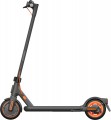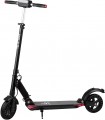Max. load
The maximum weight of the rider that the design of the scooter can withstand without breakdowns and accidents. This moment is partly determined by the age group, and mainly by the materials used in the frame. Note that manufacturers can indicate the maximum load for perfect conditions - when the scooter rides on a perfectly flat surface or even stands still. Therefore, it is worth choosing a model for this parameter with a certain margin. And even more so, you should not exceed the weight indicated in the characteristics - even if the scooter does not break down immediately, this can happen at any time after, which is fraught with accidents and injuries.
Range
The maximum distance that an electric scooter can travel on a single battery charge.
Usually the range is indicated for a flat road and driving only on an electric motor, without the help of a rider. So this indicator is quite conditional, in practice, the distance of the trip may be either less or more, depending on the characteristics of the road and driving style. Nevertheless, according to the claimed range, it is quite possible to estimate the autonomy of different models and compare them with each other.
Note that a
large range (more than 50 km) requires capacious batteries, which affects the dimensions and weight of the device. The real need for such autonomy is not required so often, especially since many electric scooters are quite capable of driving in the usual way, without the use of an electric motor.
Power
The power of the motor installed in the electric scooter. In models with two motors (one per wheel), their total power is usually indicated.
A more
powerful motor, on the one hand, has a positive effect on the speed and acceleration characteristics; on the other hand, it affects the cost of the device and requires more capacious batteries, which affect both the price and weight. In addition, at acceleration and low speeds, the scooter can be “helped” by pushing off with your foot. Therefore, in most modern models, the motor power is low — most often in range of 250 W,
300 W,
350 W. Power of 500 W is considered quite high, it allows you to reach speeds of 40 km/h and even higher. In the most advanced models, power is already measured in kilowatts, and the maximum speed can exceed 80 km/h; however, such "monsters" cost accordingly.
However, power also affects the ability to drive a vehicle, because depending on the country, various traffic rules are provided for driving a scooter.
Max. power
The power in watts that the electric scooter motor can develop at maximum speed. In general, for scooters with an electric drive, it is customary to indicate the rated engine power (see above), which ensures efficient operation of the motor for a long time. By maximum, we mean power in the “gas pedal to the floor” mode, achieved only in the short term. Using this parameter, you can roughly estimate the capabilities of a particular model, for example, in terms of speed dynamics - the more power, the faster the scooter accelerates.
Max. speed
A high top speed gives you more riding options and reduces travel time. However, it requires powerful motors and capacious batteries, which affects the price and weight of the scooter. In addition, the faster the scooter, the more careful you need to be when driving. Therefore, most of the electric scooters have a speed of
25 km / h or a little more -
30 km / h.
Pedestrian mode
The slowest speed mode (approximately from 0 to 5 – 6 km/h), is ideal for use in crowded places, for children and beginners. It controls the e-scooter while it moves at a safe speed for pedestrians to avoid collisions on crowded sidewalks.
Pedestrian mode is also suitable for leisurely walks and side-by-side trips with walking frien
Max. climbing angle
The maximum climbing angle that an electric scooter can overcome on engine power alone, without the help of legs. Models with engines of the same power may differ in this indicator (due to the difference in torque and wheel size).
Note that in the specifications the angle is usually indicated in degrees, while on road signs it is given as a percentage (1% corresponds to a rise of 1 m for every 100 m of horizontal movement). However, this moment is not particularly critical: if you often have to overcome a certain hill, you can clarify its slope by converting percentages into degrees (and vice versa) according to special tables. In addition, if the angle turns out to be too large, nothing prevents you from helping the scooter with your foot, in extreme cases, to overcome the climb on foot.
Wheels
The type and size of wheels used in an electric scooter.
The size is selected by the manufacturer depending on the general purpose of the scooter - whether it is an asphalt road or rough terrain. If we compare similar models with different wheel diameters, then it is worth considering that the larger the wheels (
10" and
larger), the better they handle road unevenness, the higher the cross-country ability and softness of the ride. And small wheels (for example,
8") in turn, they are excellent for smooth asphalt and dynamic driving; they accelerate easily and allow you to make sharp turns.
As for the different types of wheels, there are
polyurethane,
rubber,
inflatable. More details about each:
- Polyurethane. Wheels with solid polyurethane tires. This material provides good shock absorption, high-quality road grip and at the same time good rolling ability; it is resistant to temperature changes and damage, durable, and inexpensive.
— Solid rubber. In this case, we mean wheels with solid rubber tires (inflatable wheels are taken to a separate selection point). In terms of its main characteristics, rubber is similar to the polyurethane described above, and in some respects even surpasses it. Thus, such tires do not make nois
...e, smooth out asphalt roughness well, have excellent grip and provide high braking efficiency. On the other hand, this material is less durable and does not tolerate temperature changes well.
— Rubber inflatable. The most advanced type of wheels found in modern scooters. This type of wheel has an inflatable tire (like a bicycle), which provides excellent shock absorption, tight traction and high maneuverability. The disadvantages of inflatable tires, in addition to the price, include sensitivity to punctures and increased difficulty in maintenance: you need to monitor the pressure and, if necessary, inflate the tire.
— Rubber gel. Tubeless wheels filled with gel are insensitive to minor punctures and cuts. Coming out, the gel in the tire hardens almost instantly upon contact with air, effectively sealing the damaged area. In addition, such wheels require virtually no maintenance - they do not need to be inflated. The disadvantages of gel tires include their high cost and somewhat greater rigidity than inflatable tires (although such wheels are still noticeably superior to rubber wheels in terms of softness).Rear brake
Like a handbrake, the rear brake can be
drum,
electric, or
disc. In addition, there may still be a classic
foot brake, as in ordinary scooters, or not at all.
— Disk. The disc brake on the rear wheel ensures a quick stop of the scooter. These brakes have a short-stroke friction clutch. Due to the small distance between the pads and the disc, the friction clutch very quickly comes into contact with the working surface of the brake disc. In this case, the friction clutch is pressed against the disk with a sufficiently large force. The disc brake allows the scooter to stop extremely efficiently. But when using a disc brake on the rear wheel, you should be careful, because when braking hard, especially when cornering, the scooter can skid to the side.
- Drum. The drum type brake has above average efficiency. The drum brake makes the rear wheel massive and heavy. This type of brake has a closed design. The pads are inside the wheel. Friction linings rub against the inner surface of the rim. Access to the drum brake is closed by a protective cover. Thanks to the closed design, neither moisture nor other blockages get inside the brake drum, which makes the brake operation more reliable and trouble-free. Among the shortcomings can be noted: an increase in the dimensions and weight of the wheel, the complexity of maintenanc
...e.
- Foot. The simplest kind of clamping type brakes, which involves slowing down and stopping the scooter by pressing your foot on the fender of the rear wheel. Note that this is the least efficient braking system of the existing options.
- Electric - braking with the help of recuperation. The brake system of this type makes the stop extremely soft, slowing down occurs when the speed of the electric motor decreases. The rear location of the electric brake assumes that the electric motor is mounted on the rear wheel. The presence of an electric motor makes the wheel massive. The electric type brake system is highly reliable and durable, it does not require maintenance. But if the battery pack on the scooter runs out, the electric brake will not work. For such cases, an additional mechanical (hand or foot) brake is usually provided.
- Absent. The rear wheel is not equipped with a brake. In this case, the braking system is provided at the front. The advantage of scooters without a rear brake is that the vehicle will not skid to the side when braking actively when cornering.
